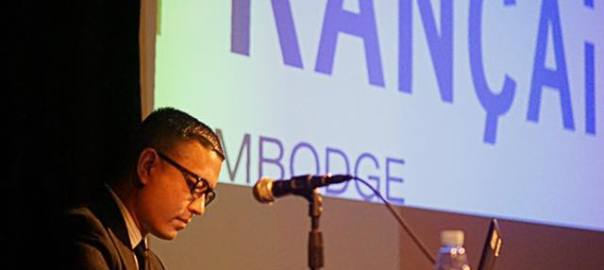Conference: “The Constitution of the Kingdom of Cambodia, 20 years after its implementation”, by Hisham Mousar – 10 May 2016

On May 10, 2016 The Association Henri Capitant Cambodia had the pleasure to organize a conference on the Constitution of the Kingdom of Cambodia by Professor Hisham Mousar, member of the Scientific Council of our association. In front of a full conference room, the legal expertise of Professor Mousar has informed the audience on the Cambodian constitutional law through an exciting presentation. Here is a detailed summary.
From the Paris Agreements compromise to a flexible constitutional practice of the Kingdom of Cambodia
On October 23, 1991 the Paris Accords were signed, ending a long period of civil war. Then was launched a constitutional process leading two years later to the proclamation of the Cambodian Constitution, dated September 24, 1993. This constitution will issue from a genuine compromise between the signatories of the peace agreements, being marked by the United Nations requirements temporarily administering the country since 1991.

This turns into several main directions in the constitution: the restoration of the monarchy demanded by the National United Front for an Independent Neutral Pacific and Cooperative Cambodia (FUNCINPEC), the preservation of national sovereignty claimed by the Khmer Rouge, the defense of Human rights asked by the National liberation Front of Khmer people (KPNLF), and the establishment of democratic institutions in accordance with the UN will and the will of the signatory countries.
From there, the political system that emerges is necessarily syncretic, with a very flexible constitutional practice which is based on the multiplication of amendments in order to end the political crisis. Nevertheless this “soft” character of the constitutional text did wave the initial balance established in 1993, fostering the claims of some parties to the Paris Agreements while limiting those of others.
Finally, we also note that the Cambodian constitution was inspired by the Western model, on one hand through an organic separation of powers and functional cooperation (checks and balances), and secondly by fully ensuring fundamental human rights guaranteed by the king and the judiciary, with the constitutional obligation for the various institutions to respect them.
The position of the parliamentary power and the codification issues
Cambodia has a bicameral Parliament consisting of a National Assembly and a Senate, the last word always returning to the National Assembly. The Senate, in addition to its legislative role, must coordinate the work of the Assembly and the government.
 In fact, the areas of law are quite uncertain and scattered while there is a real lack of formal recognition of an independent regulatory authority. Moreover, the hierarchy of norms is applied uncertainly, with superiority from the legislation on the regulation to confirm. However, the regulations, as in the great democracies, are far superior in number to the legal texts, confining Parliament in a quantitatively minor power in the creation of standards.
In fact, the areas of law are quite uncertain and scattered while there is a real lack of formal recognition of an independent regulatory authority. Moreover, the hierarchy of norms is applied uncertainly, with superiority from the legislation on the regulation to confirm. However, the regulations, as in the great democracies, are far superior in number to the legal texts, confining Parliament in a quantitatively minor power in the creation of standards.
We can also note that the codification can sometimes be difficult, as illustrated by the rejection of the 2010 Criminal Code by the defenders of human rights, while it was yet less repressive than the Code of UNTAC (United Nations Transitional Authority in Cambodia), particularly regarding the freedom of expression. A real challenge that faces justice is the interpretation by the judge of law texts and legislation as the Cambodian jurisprudence is not yet sufficiently predictable and creates a form of legal uncertainty for citizens. These codification problems are also embodied in the Civil Code which the drafting makes the understanding and interpreting complicated because of a precarious balance between the logic of civil law jurists and the common law jurists, making its understanding very difficult if not impossible by some as by others.
An executive with strong regulatory powers and important resources
The executive power has, like in France, a leading role in the creation of regulations. It has large resources, including human, with in Cambodia nearly 232 members including 56 government ministers for 23 departments.
A number of administrative authorities significantly increase the executive normative power. A distinction must be made between two types of structures: those divided even within governments, and those with an industrial and commercial task. The interest for the government is probably to distribute power by adapting to international practices.
In conclusion: the Constitution dated 1993 contains the most liberal constitutional foundations
 Sovereignty is indeed defined as national (not popular), the monarchy works just like that of the UK, authorities are subtly separated and distributed following the logic of parliamentarism, and the rights guaranteed by a Constitutional Council and an independent judiciary. In constitutional practice, the government has a strong power, including through increased regulatory power, a system that has prevailed throughout the 5th Republic in France.
Sovereignty is indeed defined as national (not popular), the monarchy works just like that of the UK, authorities are subtly separated and distributed following the logic of parliamentarism, and the rights guaranteed by a Constitutional Council and an independent judiciary. In constitutional practice, the government has a strong power, including through increased regulatory power, a system that has prevailed throughout the 5th Republic in France.
This event is part of the Association Henri Capitant Conference cycle that will continue within schools, universities, and research institutes partners and friends of the Association.
We will certainly keep you informed of upcoming events to come.
